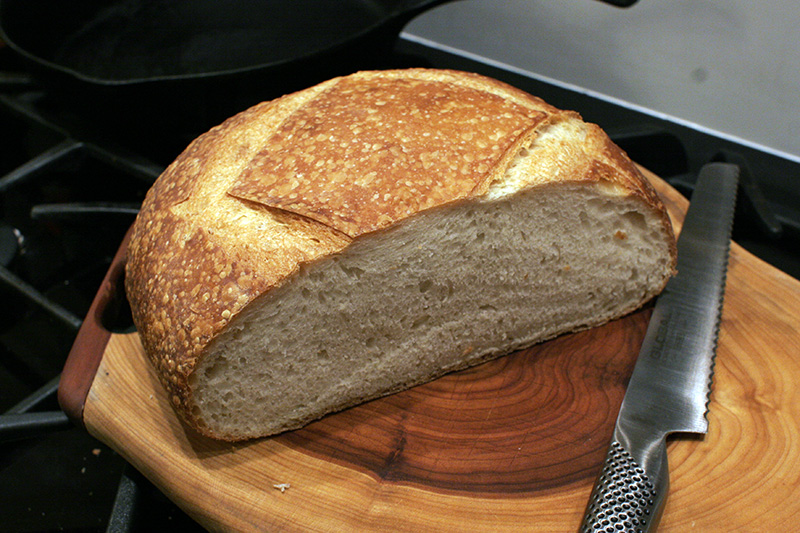
Cra-zee oven spring
Most of the bread I bake is either the Whole Wheat Levain recipe from Hamelman's Bread or the Basic Sourdough recipe from BBA.
Generally I like the whole wheat bread better, particularly since I switched to a mix of mostly white whole wheat with just a little red coming from the starter (I feed it with cheap, but fresh, red whole wheat flour I get at my grocery store). But I've been playing with some tweaks to the white-flour sourdough, particularly since I bought a bunch of moderately-priced organic bread flour (the Sperry product) from NY Bakers.
The organic bread flour is really more of an AP flour at 12% (nominal) protein. It's just wheat, no malted barley flour to correct the falling number. I've had slightly denser loaves than I was used to from conventional flour and a bit of a problem with the crust not browning as much as I'd like.
I made two slight tweaks to the recipe today:
1) Rather than making a stiff levain and retarding that overnight, I simply mixed the full recipe except the salt using my 100% hydration culture and retarded that. In the morning, I let it come up to room temp, added the salt, kneaded, and let it rise. I have been using a pretty long bulk fermentation time -- 5 hours at 80F in my bread machine -- since switching to the organic flour, and that's what I gave this loaf.
2) I used about 1/4 All Trumps and 3/4 organic flour. This should have bumped up the protein level to about 12.5% -- about like KA Bread flour -- though what I was really looking for was slightly better browning from the malt used to bring the All Trumps within spec.
I did get somewhat better browning, and there was a change in the texture of the bread -- less chewy and slightly softer. The other thing I got was completely insane oven spring even though I slightly overproofed the loaf -- the boule popped up until it almost hit the next rack in the oven!
Since the net protein content wasn't that high I'm not sure which change was responsible for the wild oven spring. I guess I'll redo the experiment twice and see which change it was, or whether it was both in combination.




I'm jealous of the crumb you got on that!
I just did a half-WW half-bread flour batch a day or two ago that came out great, the density was pretty nice, but I'd be happier if it was a little lighter like yours there.
I might have to try something like you describe on my next batch of that.
2 days ago I baked 3 loaves that looked exactly like yours. I preheated the oven with a baking stone for 40 minutes at 500ºF, got two of the loaves in, and realized that the third one wouldn't fit, so I baked that one after the first two. By then the oven had been on for almost 2 hours, and that last loaf rised about 2 inches higher than the first two. Since that third loaf was originally shaped as a giant batard that got mangled during my attempt to fit it in with the first batch, and got reshaped as a boule and left to re-proof while the first batch was baking, I can't be sure whether it was the hotter oven or the double proofing that did it.
I tried this same technique again except with the Hamelman Whole Wheat Levain which is my other everyday bread.
It was a disaster. The dough was extremely difficult to handle -- very sticky despite repeated adjustments -- spread out uncontrollably while proofing, and had hardly any oven spring at all. I think I just lost too much gluten during the prolonged cold fermentation -- and that the separate whole-wheat starter I keep, which has been tending towards soupy, has already lost too much gluten to this same process. I've never seen "gluten attack" before but I think this much be it.
Next time I try this with the whole wheat recipe I will add the salt before the long soak in the fridge. My understanding is that should keep enzyme activity somewhat under control and protect the gluten so my bread doesn't keep trying to turn itself from levain into lavash after I shape it.